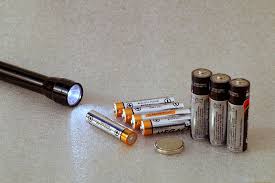Especially up here in the northeast, and pretty much across the country, winter means that daylight is short. It’s starting to get dark around 5:30pm. That gets me thinking about if I have the right equipment for conditions, including batteries.
I’m thinking about, “Do I have my light with me? Is my light charged up with good batteries?”
A good, powerful, high-output defensive type of flashlight is something you should have on you at all times. It’s certainly in my minimum EDC kit. I’m talking about a handheld flashlight for utility purposes and one for defensive purpose to identify threats.
All of these, supplemented with a pistol-mounted light or a rifle-mounted light, depending on what you want. It gets me thinking this time of year, because I use my light all year for random things.
What I like to do this time of year is swap out batteries in my lights.

Whether it needs it or not, I’ll take those batteries and I’ll put them in my training battery light. So, when I’m out hitting the range and I’m working on low light skills, I’ll use those batteries and just let them run out.
I want to make sure this time of year that I also have fresh batteries, because of the darkness. Since, if we look at our clock, the darkness will outweigh light.
These important steps go for you, too. I want to make sure we have all our low light tools powered up with new fresh batteries, and they’re ready to go.
On the subject of batteries, it’s probably not a bad idea to swap batteries for our other battery-operated equipment, too.
For instance, if you run red dots, lasers, things like that, what I’d like to do is, every year, whether those devices need a new battery or not, I swap them out like I do with my flashlight batteries.
So when taking those batteries out, I won’t throw them away. I’ll hang on to them and I’ll put them in a bag and mark them that they’re used. These batteries I will use when I’m doing training things and stuff or keep in my range bag, so when a guide light or a red dot goes down, I have a battery that at least has some juice left in it.
I know a lot of these red dots on most of my rifles have about a five-year battery life, with a constant arm, which is pretty impressive. However, I don’t want to wait five years for that thing to run out. I’d rather be safe than sorry and swap those out. That’s something I do about every year. This is usually about the time that I do it.
While we’re thinking about things like swapping batteries, making sure our equipment is ready to rock…
I like to do a good zero confirmation, specifically on my rifles I own that have optics on them, red dots or scopes. These are primary use rifles for defensive purposes and patrol rifles for my job.
I’ll get them out at the range and do a good 50 yards zero on them. I’m not talking about piling on a bunch of ammunition here. I’m doing a few three to four shot strings, volleys, just checking my zero confirmation.
At the same time, I’m also checking my iron sight and zero, making sure the thing is dialed in. See, zeros that can be fluid. You’d be surprised how things change.
It’s always a good idea to dial them in and make sure everything is good. I sometimes, I have to go a click or two in one direction to dial in a little bit. It’s usually pretty close, but sometimes there are some minor adjustments.
While we’re on the topic of checking your gear and cycling things out, I like to hit the range and cycle through my duty and carry ammunition. Whenever I’m using carry ammunition in my duty pistols for work, or my concealed carry guns or my backup guns, when I hit the range this time of year I dump that ammo. I use it for whatever drill I’m working on, go through those magazines or stripper clips, then I’ll freshen those up after the training event with fresh carry and duty ammo.
